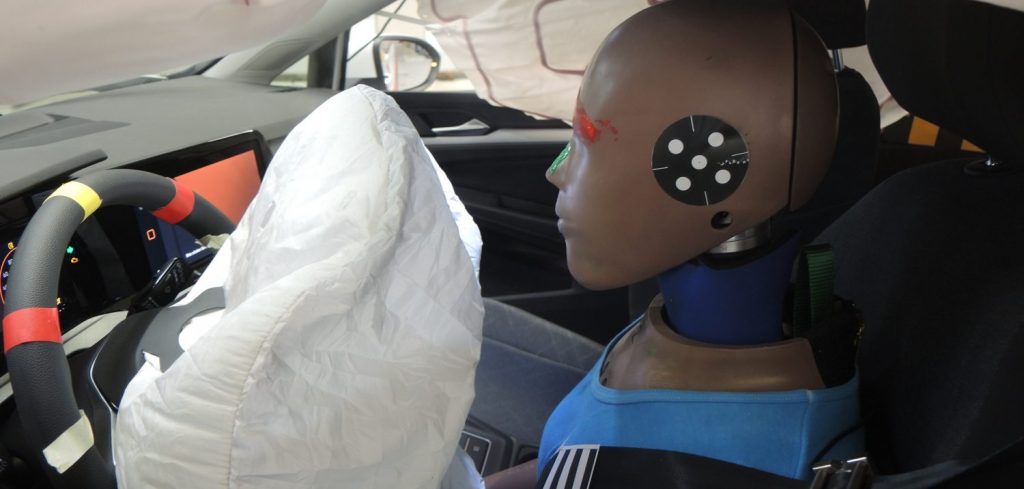As ongoing research highlights the vulnerability of certain occupants in crashes, industry experts continue to improve their testing techniques and ultimately devise next-generation protection systems
Since crash testing was first implemented in the middle of the last century, much of the focus has been on the average male driver – a fact that has been the subject of discussion and even controversy in recent years.
In the National Highway Traffic Safety Administration’s report of 2013 titled Injury Vulnerability and Effectiveness of Occupant Protection Technologies for Older Occupants and Women, the organization’s research concluded that the fatality risk to female occupants in a frontal collision is 17% higher than for their male counterparts of the same age.
The report goes on to say that females are more susceptible to neck and abdominal injuries and, at lower severity levels, highly susceptible to arm and leg fractures. It also states that seatbelts are less effective for female passengers in a vehicle but more effective for female drivers.
This research was further supported by a study released in 2019 by the Center for Applied BioMechanics at the University of Virginia which showed that females are 73% more likely to be injured in a frontal crash than a male. The work concluded that females are at greater risk of Abbreviated Injury Scale (AIS) 2+ and AIS 3+ injuries compared with males, even after taking into consideration other factors such as age and body mass index (BMI). Taking into account research by Bose et al in 2011, the reports states that a belt-restrained female is 47% more likely to sustain serious injuries than a male in a similar crash scenario.
Principal scientist Jason Forman ( left), one of the authors of the report, says that it’s unclear exactly why this is the case. “The first step is to understand more about why females are at greater risk,” he tells Automotive Testing Technology International. “There are a host of factors that could potentially contribute, ranging from differences in the tolerance of the body to mechanical load, to differences in body shape influencing how the body interacts with the restraint systems. But the simple fact is that we don’t yet know which, if any, of these factors are actually driving the differences that we see in the field.”
left), one of the authors of the report, says that it’s unclear exactly why this is the case. “The first step is to understand more about why females are at greater risk,” he tells Automotive Testing Technology International. “There are a host of factors that could potentially contribute, ranging from differences in the tolerance of the body to mechanical load, to differences in body shape influencing how the body interacts with the restraint systems. But the simple fact is that we don’t yet know which, if any, of these factors are actually driving the differences that we see in the field.”
Forman says that while no actual testing was performed for the study, the incorporation of gender-related factors into virtual and physical models is a topic of ongoing research at the university in its attempt to help find a solution.
“Until we understand more about what specifically is contributing to the difference in risk, we are not going to know how to craft a solution,” he comments. “This is going to require continuing fundamental research relating to biomechanical differences across the population, and how they translate to differences in injury risk in collisions.”
OEMs and agencies including the NHTSA, ADAC and Global NCAP are undertaking research in a bid to establish not just those factors, but also what the parameters should be to integrate their findings into vehicle engineering.
Lotta Jakobsson, senior technical leader for injury prevention at Volvo Cars in Sweden, agrees that females are under-represented in crash test data: “Most standardized test procedures include crash test dummies representing a mid-size male, while only a few include dummies representing a small-size female. Obviously, these two sizes do not represent all occupants.”
However, Jakobsson adds that the data does not actually reflect a major difference between males and females. “When looking into our own data on Volvo cars, we don’t see a major overall difference between women and men,” she notes. “This is a result of dedicated work focusing on real-world safety. We have collected and analyzed data from real-world crashes systematically and continuously since 1970, which has helped us to improve safety over the years. Through this way of working, individual differences in gender, age and size are natural parts of the development process.”
According to the Insurance Institute for Highway Safety, much of the uncertainty emanates from a misconception about the role of the crash test dummy. It says that the main objective of passive safety is to ensure that the physical structure of a vehicle resists intrusion into the occupant compartment. If the structure maintains its integrity correctly, then whatever or whoever is inside will be protected. This protection is enhanced with the support of active safety equipment.
 This view is echoed by safety test center ADAC in Germany, as Volker Sandner (left), senior manager, vehicle safety, says, “A dummy itself gives a certain picture of a person. The key is what you use with the dummy.”
This view is echoed by safety test center ADAC in Germany, as Volker Sandner (left), senior manager, vehicle safety, says, “A dummy itself gives a certain picture of a person. The key is what you use with the dummy.”
One option is to increase the availability of dummies to test a broader range of body types, but the consensus is that this would be prohibitively expensive. The alternative is to conduct more virtual testing, which enables analysis of different impact angles at various speeds and with multiple types of ATD. “The future intention is that we will have a spread of dummies that we can use, and then we will do a cross-check virtually,” Sandner comments.
Experts believe that closer collaboration between OEMs and agencies will enable a more inclusive evaluation process. Ideally OEMs would conduct more of their own tests, both physically and virtually, and then provide that data to agencies such as Global NCAP for verification, in addition to performing independent tests. This approach would widen the scope of analysis to incorporate a greater variety of crash scenarios as well as individuals.
Ultimately though, a combination of elements will ensure the safest solution, says Jakobsson. “The protection of occupants is a combination of active safety technologies, such as autobrake (which reduces the speed of impact), car body design and restraint systems such as safety belts and airbags. These different parts can be used to adapt the protective [measures] to the diverse population.”
Concludes Forman, “In general I think the most important lesson is that there is still room for improvement, so we should continue to explore potential solutions wherever they may lie, including restraint-based and active safety solutions.”



